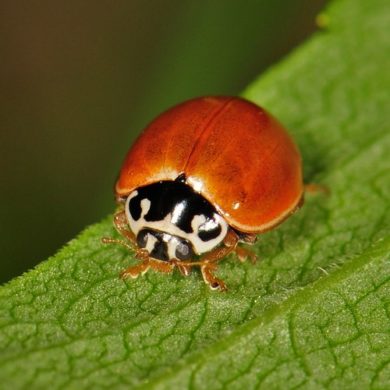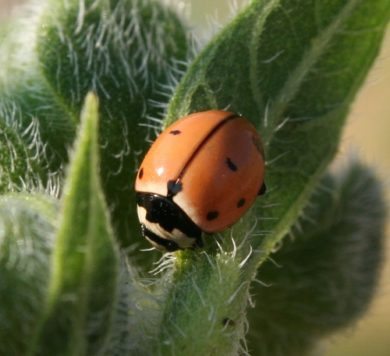Here at the Vermont Atlas of Life we're always on the lookout for historic biodiversity data. When we find it, our mission is to save it from potentially being lost in the dustbin of history. Recently, we unearthed a 40+ year old document - Lady Beetles: A Checklist of the Coccinellidae of Vermont. The authors listed the first and last date each species was collected in Vermont and the total number of specimens known, a snapshot of Lady Beetle life in Vermont prior to 1976.
Since at least the 1980s, native Lady Beetles that were once very common across the Northeast have become rare or have even gone missing. But there was little information readily available from Vermont. Spurred on by this old document, we began to assemble as much data as possible. After digitizing records from the historic document, adding Vermont records from Cornell University’s Lost Ladybug Project, other historic collections in Vermont, and observations from the Vermont Atlas of Life on iNaturalist, and organizing existing records, we now have over 4,000 records (up from 865 records in 2020!) representing 43 lady beetle species (seven introduced) available for use.

Polished Lady Beetle © Jason Michael Crockwell
Most records come from Vermont Atlas of Life iNaturalist users contributing photographs of these beetles. In 2018 alone, 14 verified species were documented from 119 observations. And observers have contributed some unique Vermont records to crowd-sourced databases:
- Undoubtable Lady Beetle (Brachiacantha indubitabilis) – the first and only state record was found in 2014 and reported to BugGuide.net.
- Hieroglyphic Lady Beetle (Coccinella hieroglyphica kirbyi) – the last record in Vermont was reported in 1969 until one was reported to VAL on iNaturalist in 2017.
- Mountain Lady Beetle (Coccinella monticola) – the first and only state record was reported to VAL on iNaturalist in 2017.
- Octavia Lady Beetle (Hyperaspis octavia) – the first and only state record was reported to VAL on iNaturalist in 2020.
Why We Need Them
Lady beetles, aka ladybugs, are adored by many. But they are also important for farmers. Many species eat plant pests like aphids, scale insects, and mealybugs – which can be serious pests of trees, vegetables, and flowers. Lady beetles lay hundreds of eggs and when they hatch, the larvae immediately begin to feed. Several species are even collected and sold to growers for control of insect pests. Species diversity is incredibly important to pest suppression. As invasive Lady Beetle species crowd out the native ones and diversity declines, the risk of pest outbreaks could grow.
The Missing Lady Beetles in Vermont

This Nine-spotted Lady Beetle was photographed in Utah. The last record for this species in Vermont is from 1976. © Rebecca Ray
What species are we missing now? Twelve of Vermont’s 36 known native species have not been reported since the 1976 checklist was completed. Three of these species were designated as “species of greatest conservation need” in 2015 in New York: Two-spotted Lady Beetle (Adalia bipunctata), Nine-spotted Lady Beetle (Coccinella novemnotata), and Transverse Lady Beetle (C. transversoguttata). And the Nine-spotted Lady Beetle was recently declared “Endangered” in Canada.
An extensive USDA APHIS survey in 1993 failed to find any Nine-spotted Lady Beetles in 11 Northeastern states, including Vermont. Experts thought that both the Two-spotted and the Nine-spotted lady beetles were extinct in New York until citizen scientists rallied to help Cornell University’s Lost Ladybug Project search for them. In 2009 the Two-spotted was reported from western New York and in 2011 citizen scientists discovered several Nine-spotted lady beetles on Long Island.
Our Vision
The Vermont Lady Beetle Atlas was inspired by a desire to uncover similar answers about Vermont’s missing Lady Beetles. Through our research, we hope to pick up where the Lost Ladybug Project left off and amass a database of current Lady Beetle species in Vermont. Through this work, we want to discover whether missing Lady Beetle species still exist at low levels in some regions or if they truly are gone. Our long-term goal is to restore Vermont’s Lady Beetle diversity and counteract the proliferation of invasive Lady Beetles by reintroducing some of these lost species. Ultimately, by tackling unanswered questions about Vermont Lady Beetles and keeping our thumb on the pulse of Lady Beetle conservation, we hope to provide insight and support to those tackling environmental issues across the state.
How You Can Help
Combing Vermont’s forests, fields, and gardens for missing Lady Beetle species is an important mission and we definitely can’t do it alone! You can help us by photographing any Lady Beetle you come across and sharing it to the Vermont Lady Beetle Atlas on iNaturalist. No experience necessary! For those who want to learn more about Lady Beetle identification, the Discover Life pictorial key is a great resource.
At this time, we are outlining a plan for the coming field season, so stay tuned for other ways you can get involved!






